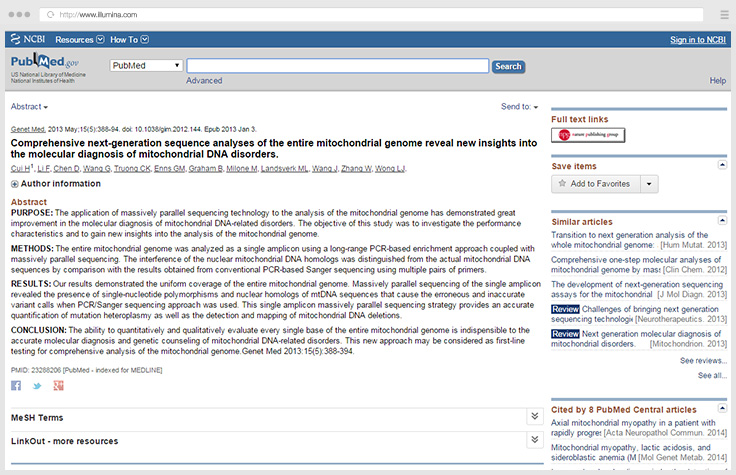Mitochondrial Sequencing
Introduction to Mitochondrial Sequencing
Mitochondrial disorders are heterogeneous diseases that can arise at any stage of life. Studying mutations associated with mitochondrial disorders remains a challenge due to phenotypic variability and genetic heterogeneity among individuals.
Mitochondrial sequencing with next-generation sequencing (NGS) technology addresses these challenges, enabling comprehensive detection and analysis of mitochondrial disease-associated variants. NGS also enables mitochondrial DNA analysis for other applications such as human identification, forensics, and cancer research.
Benefits of NGS-Based Mitochondrial Sequencing
Mitochondrial sequencing with NGS enables:
- Detection of common and uncommon mitochondrial point mutations and deletions1,2,3,4
- Rapid analysis of both mitochondrial DNA (mtDNA) and nuclear DNA (nDNA)2,4
- Accurate, sensitive measurement of heteroplasmy1 (more than one mitochondrial DNA sequence variant in a given sample)
- Analysis of the D-loop hypervariable region (a noncoding mtDNA region that's a hotspot for genetic alterations5) and/or the entire mitochondrial genome
Common NGS Methods for Mitochondrial Sequencing Studies
Common NGS methods for analyzing mitochondrial disease-associated mutations include whole-exome sequencing and targeted gene sequencing.
Whole-exome sequencing analyzes the protein-coding regions of the genome, with the capability to expand to include untranslated regions (UTRs) and microRNAs if desired.
Targeted gene sequencing focuses on specific genes or gene regions of interest with known or suspected disease associations.
Compare the two methods in the table below.

Compare Mitochondrial Sequencing Methods
| Method | Whole-Exome Sequencing |
Targeted Sequencing |
| Description | Provides a complete picture of the coding regions of the mitochondrial genome. Enables researchers to take a closer look at the mitochondrial regions where causative variants are often found. |
Focuses on particular mitochondrial genes or regions. Utilizes sequencing panels that are selected based on a priori knowledge of mitochondrial disease-associated variants. |
| Advantages |
|
|
| Considerations |
|
|
| Additional Information | Learn More About Exome Sequencing | Learn More About Targeted Sequencing |
Featured Mitochondrial Sequencing Solutions
Illumina DNA Prep with Exome 2.5 Enrichment
A cost-effective, reliable human whole-exome sequencing solution, with the option to add mitochondrial genome coverage using a spike-in panel that allows sequencing of mitochondrial DNA variants.
NovaSeq 6000 System
This instrument expands sequencing capabilities by combining throughput, flexibility, and simplicity for virtually any method, genome, and scale.
Analyzing mtDNA, piRNA, and TCR Repertoire Diversity
Researchers at Mount Sinai use Illumina sequencing to develop novel methods for studying mitochondrial DNA, piwi-interacting RNA, and T cell receptor repertoire diversity. Their goal is to unravel cancer, infertility, and autoimmune disease mechanisms.
Read Article
mtDNA Analysis for Forensics and Human Identification Studies
Since mtDNA is present in hundreds to thousands of copies per cell, it can survive environments where nuclear DNA does not. This makes mtDNA analysis a powerful tool for human identification. However, heteroplasmy (the principle that mtDNA sequences may be tissue type-specific or even vary within a single cell or tissue type) can make it difficult to confirm sample associations needed for forensic identification.
Illumina NGS enables accurate detection of mitochondrial DNA heteroplasmy and high resolution of mixed samples.
Analysis of Skeletal Remains with Deep mtDNA Sequencing
Forensic researchers use Illumina NGS to identify skeletal remains by sequencing mtDNA hypervariable regions.
Interested in receiving newsletters, case studies, and information on genomic analysis techniques? Enter your email address.
Additional Resources

Analyzing Mitochondrial Mutations with NGS
NGS enables analysis of the whole mitochondrial genome, providing researchers with a summary of molecular defects.

NGS Insights for Mitochondrial Disease Research
Massively parallel sequencing provides a comprehensive, one-step molecular analysis of the mitochondrial genome.

Identifying Heteroplasmy
NGS enables researchers to quantify heteroplasmy accurately and detect mutations and deletions in mtDNA.
References
- Tang S, Wang J, Zhang VW, et al. Transition to next generation analysis of the whole mitochondrial genome: a summary of molecular defects. Hum Mut. 2013;34:882-893.
- Wong LC. Next generation molecular diagnosis of mitochondrial disorders. Mitochondrion. 2013;13:379-387.
- Chinnery PF, Elliott HR, Hudson G, Samuels DC, Relton CL. Epigenetics, epidemiology and mitochondrial DNA diseases. Int J Epidemiol. 2012;41:177-187.
- Calvo SE, Compton AG, Hershman SG, et al. Molecular diagnosis of infantile mitochondrial disease with targeted next-generation sequencing. Sci Transl Med. 2012;4:118ra10.
- Sharma H, Singh A, Sharma C, Kumar Jain S, Singh N. Mutations in the mitochondrial DNA D-loop region are frequent in cervical cancer. Cancer Cell Int. 2005;5:34.
